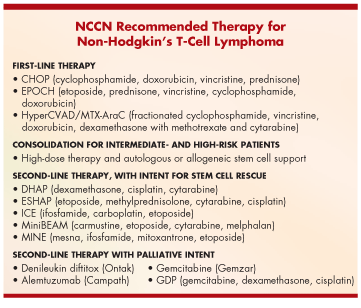T-Cell Lymphoma Gets Its Own NCCN Treatment Guideline
The management of peripheral T-cell lymphoma may become more uniform with the release of the first set of clinical practice guidelines for the disease
HOLLYWOOD, FloridaThe management of peripheral T-cell lymphoma may become more uniform with the release of the first set of clinical practice guidelines for the disease from the National Comprehensive Cancer Network (NCCN). "This is not a common disease, but it exists. There was a sense that clinicians were not treating patients with any kind of a uniform approach, so this is the beginning of such an approach," Leo I. Gordon, MD, Abby & John Friend Professor of Cancer Research, Northwestern University Feinberg School of Medicine, told ONI.
Peripheral T-cell lymphoma (unspecified) makes up approximately 5% to 7% of all non-Hodgkin's lymphoma cases and between 60% and 70% of T-cell lymphomas. A fine-needle aspiration biopsy alone is not sufficient for the initial diagnosis of peripheral T-cell lymphoma. Essential work-up involves adequate immunophenotyping, including a full paraffin panel; cell surface marker analysis by flow cytometry; and additional immunohistochemical studies if needed to establish lymphoma subtype. Molecular genetic analysis is also required to detect antigen receptor gene rearrangements and variants, Dr. Gordon said.
The guidelines detail all steps to follow during the work-up of a patient with suspected peripheral T-cell lymphoma and recommend that prophylaxis for tumor lysis syndrome be considered during induction therapy for stage I and II disease. Follow-up therapy for complete response, partial response, and no response or progressive disease, as well as end of treatment restaging for these categories, is described.
The NCCN T-cell lymphoma panel recommended that patients be enrolled in a clinical trial whenever possible for optimal management.
First-line therapy should encompass aggressive regimens (see Table). The panel also noted that intermediate- and high-risk patients be consolidated with high-dose therapy and autologous or allogeneic stem cell support.
Recommended second-line therapy includes regimens with intent for stem cell rescue and therapy with palliative intent (see Table).

These first guidelines stress the importance of trying to identify targets such as vascular endothelial growth factor (VEGF) or CT 25 because "now we have antibodies or peptides that can attack these targets," Dr. Gordon commented.
He said that it has now become possible to identify prognostic factors more accurately than ever before, due to better, more sophisticated technology. "Before, we relied on clinical techniques, which are valuable. But now, the big question is whether molecular prognostic factors trump the clinical prognostic factors. Which is more predictive? Should you follow the old school of thinking or should you treat every patient who has a p53 mutation, regardless of whether they feel well or not?"
The panel also said it was no longer essential to do a bone marrow biopsy in these patients to diagnose chronic lymphocytic leukemia (CLL). "This has been a bone of contention, if you will, because we used to do bone marrows in patients with follicular lymphoma and CLL routinely. But it's probably not necessary because we don't act on the results anyway, so why put somebody through that," Dr. Gordon said.